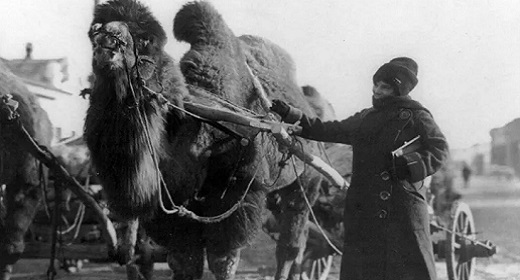by Matt Hickman: Although climbing mountains, documenting exotic lands and traversing some of Mother Nature’s most extreme landscapes might not be considered gender-exclusive activities today…
they were once very much the endeavors of men only. Well, men and a select handful of tenacious women who saw beyond their prescribed societal roles and just went out and did it.
We’ve rounded up several notable female adventurers of the 19th and early 20th centuries who blazed the trail, sometimes literally, for their modern counterparts.
Isabella Bird (1831-1904)
You could say the life of perpetually on-the-move socialite turned globetrotting adventurer turned missionary Isabella Bird served as one big, eye-opening geography lesson for Victorian England. It’s only fitting, then, that after decades of bouncing from continent to continent, Bird became the first woman inducted into the Royal Geographical Society in 1872.
We won’t list all the remote corners of the globe that the author of “A Lady’s Life in the Rocky Mountains” visited during her action-packed life, but a handful of Bird’s most remarkable feats are worth mentioning. She scaled Hawaii’s volcanic peaks, traveled hundreds of miles down China’s Yangtze River, lived among the indigenous Ainu people of Hokkaido and tamed a one-eyed mountain man known as Rocky Mountain Jim.
Although Bird thrust herself into many uncomfortable — and at times, perilous — situations and disregarded the restrictive societal bounds of Victorian femininity, she was still very much a lady. To that end, she refused to divulge whether her relationship with her hirsute hiking companion in the Colorado Rockies was ever anything more than platonic. Today, Bird’s adventurous and uncompromising spirit lives on not only in her published letters but in a line of crinkled tunics and smocked dresses.
Annie Edson Taylor (1838-1921)
Although her passport didn’t see as much action as most of the women on this list, retired schoolteacher Annie Edson Taylor will forever be remembered as a grade A adventurer and a game-changing daredevil.
On her 63rd birthday, Oct. 24, 1901, Taylor stuffed herself inside a mattress-padded oak pickle barrel and sailed over Niagara Falls (Horseshoe Falls, to be exact). Nearly 90 minutes after being set adrift and plunging more than 150 feet, the top of Taylor’s custom-made barrel was sawed off and she emerged unscathed except for a few minor bumps and bruises. On that day, Taylor became the first person, male or female, to ride down Niagara Falls in a barrel. Her first words post-plunge? “No one ought ever do that again. I would sooner walk up to the mouth of a cannon, knowing it was going to blow me to pieces than make another trip over the fall.”
Widowed when her husband was killed in the Civil War, Taylor hoped that her stunt would earn her both fame and financial security after years of hardship. Although Taylor’s ride briefly dominated international headlines, her infamy soon faded. She died, blind and penniless, at 83.
Fanny Bullock Workman (1859-1925)
Although she first gained recognition for partaking in and writing about epic cycling expeditions through exotic locales (India, Algeria, Italy, Spain, etc.) in the company of her just-as-adventurous husband, New England socialite turned alpinist Fanny Bullock Workman is perhaps best known for opening doors and breaking records in the realm of female mountaineering.
From the Swiss Alps to the Himalayas, there was no peak Workman wasn’t game to conquer. During a handful of Himalayan expeditions, Workman set several altitude records, including the ascension of Pinnacle Peak (22,810 feet) in 1906. She was 47 at the time. An incredibly aggressive and tenacious mountaineer who was immune to altitude sickness, Workman was in constant competition with Annie Smith Peck, another trailblazing female climber who turned heads about the same time in the male-dominated sport.
The second woman to address the Royal Geographic Society — Isabella Bird was the first — Workman was an outspoken supporter of the suffrage movement who had no qualms with challenging how Victorian women were supposed to conduct themselves. The fascinating Workman didn’t just climb mountains; she moved them.
Nellie Bly (1864-1922)
Best known as an investigative journalist whose undercover stint inside a mental institution loosely inspired Sarah Paulson’s character on “American Horror Story: Asylum,” Nellie Bly was also one heck of a world traveler, although she didn’t exactly stick around long in the far-flung locales she visited. After all, she had a record to beat.
On Nov. 24, 1889, the 25-year-old Bly (born Elizabeth Jane Cochrane) set out to one-up fictional Victorian globetrotter Phileas Fogg by circumnavigating the world in less than 80 days. Seventy-two days, six hours, 11 minutes and 14 seconds later, Bly had conquered the Jules Verne protagonist’s time with her whirlwind — and mostly solo — trip from New York to New York with stops in England, France, Egypt, Sri Lanka, Singapore, Japan, Hong Kong and San Francisco. Like Fogg, Bly traveled strictly by rail and steamer. Hot air balloons never entered the equation. Bly’s nearly 25,000 mile adventure, sponsored by Joseph Pulitzer-published newspaper The New York World, was beaten just a few months later by world-class eccentric dude George Francis Train, who completed the journey in 67 days.
Gertrude Bell (1868-1926)
Mountaineer. Archeologist. Writer. Cartographer. Diplomat. Linguist. Museum founder. British spy. This is just a brief list of titles that could apply to the inimitable Gertrude Bell.
Often referred to as “Gertrude of Arabia,” Oxford-educated Bell was, above all, a nation-shaper who played an integral role in transitioning Mesopotamia into modern-day Iraq after World War I. Bell drew borders, installed a monarch (who was loyal to the British), and helped reorganize and stabilize a wobbly government. If Bell’s name rings, well, a bell, it may be because of a recent flurry of interest in her legacy amid the current Middle East instability. Writes The New York Times: “Seen through the experience of Iraq’s tumultuous recent past, the decisions made by Miss Bell … hold cautionary lessons for those seeking to bring stability or seek advantage in the region now.”
Bell, who overdosed on sleeping pills in Baghdad at age 57, remained a staunch anti-suffragist to the end. She is the subject of an upcoming Werner Herzog-helmed biopic titled “Queen of the Desert” starring Nicole Kidman as Bell and Robert Pattinson as Bell’s protégé, T.E. Lawrence.
Annie Londonderry (1870-1947)
Picking up where the intrepid Nellie Bly left off, in 1894 Annie “Londonderry” Cohen Kopchovsky caused Victorian jaws to drop by also circumnavigating the globe. However, whereas Bly completed her journey in the relative comfort of steamship and rail, the Latvia-born Londonderry bicycled — yes, biked — from Boston to Boston via France, Egypt, Jerusalem, Sri Lanka, Singapore and other locales. Of course, considering that Londonderry was an exceptional woman, not a bike-straddling sorceress, boats and trains did come into play at certain points (i.e., traversing bodies of water).
Completing the journey — the “most extraordinary journey ever undertaken by a woman” per The New York World — in 15 months, the bloomer-wearing Londonderry’s adventure was an early example of stunt marketing. She rented her body and bicycle (a 42-pound Columbia, in case you were wondering) to savvy advertisers who were quick to realize that all eyes would be on the young mother as she circled the world. In fact, the globetrotting cyclist’s adopted surname is taken from her main corporate sponsor: a bottled mineral water company based out of Londonderry, New Hampshire. Talk about a true spokeswoman.
Harriet Chalmers Adams (1875-1937)
Although Harriet Chalmers Adams, a no-compromise American adventurer of the highest order, has faded into relative obscurity, she was a force of nature back in her day.
A longtime correspondent and photographer for National Geographic magazine and the founding president of the Society of Woman Geographers, Adams was essentially your wanderlust-stricken Great Aunt Enid — the one with the never-ending slideshows and well-worn passport — on steroids. Shortly into her marriage to Franklin Adams, the California-born explorer and her husband embarked on a 40,000 mile, three-year adventure across South America, a trip that included traversing the Andes on horseback and canoeing down the Amazon River.
Future travels found Adams exploring Haiti, Turkey, the South Pacific, Siberia and France where, as a wartime correspondent for Harper’s magazine, she was the only American female journalist permitted to enter the trenches during WWI. Throughout Adams’ tenure with National Geographic, many readers were shocked to find that some of the magazine’s most perilous reports and astonishing photographs were the work of a woman.
Louise Boyd (1887-1972)
When Louise Boyd inherited the family fortune at age 33, the Marin County, California, native didn’t go buck wild buying fancy clothes or embarking on lavish European tours. Instead, the intrepid heiress set her sights way north and used the money to help fund several important expeditions in the Arctic and Greenland.
The first woman (at age 68) to fly over the North Pole, Boyd — or the “Ice Woman,” as she was referred to in the press — enjoyed a certain degree of notoriety after her early trips to the Arctic, which involved hunting polar bears with European aristocrats. A keen photographer and researcher, Boyd’s later expeditions were decidedly more productive and scientific, including a survey of northeastern Greenland’s fjords and glaciers, and an Arctic trip to study the effect of polar magnet fields on radio communications.
Perhaps most famously, in 1928 Boyd was involved in the 10-week-long search and rescue mission for Norwegian explorer Roald Amundsen, who disappeared while searching for missing Italian explorer Umberto Nobile. Although Amundsen was never found, Boyd was presented with a Chevalier Cross of the Order of St. Olav by King Haakon of Norway for her valiant and unremitting participation in the search.
Junko Tabei (1939-2016)
While only 4 feet 9 inches tall, Junko Tabei was a mountain onto herself in the world mountaineering. In 1975, at the age of 35, she became the first woman to ascend to Everest’s peak, leading a team of other women. Tabei climbed the remaining six mountains that, with Everest, make up the Seven Summits, or the highest peaks on each continent: Kilimanjaro in Africa in 1981; Aconcagua in South America in 1987; Denali in North America in 1988; Vinson Massif in Antarctica in 1991; and in 1992, she scaled both Puncak Jaya of Oceania and the west peak of Elbrus in Europe.
While climbing mountains isn’t an easy task, the endeavor was even more challenging for Tabei, who encountered cultural obstacles. In the 1970s, Japanese women were still expected to stay home or serve tea in offices, not form mountain climbing clubs or secure sponsorship for climbing Mount Everest, both of which Tabei did. In addition to breaking gender norms, Tabei advocated for sustainability at Everest and other summits.
Tabei was diagnosed with cancer in 2012, but according to the Japanese national broadcaster NHK, she continued to her mountain climbing activities while receiving treatment. She died of cancer in 2016 at the age of 77.


























































